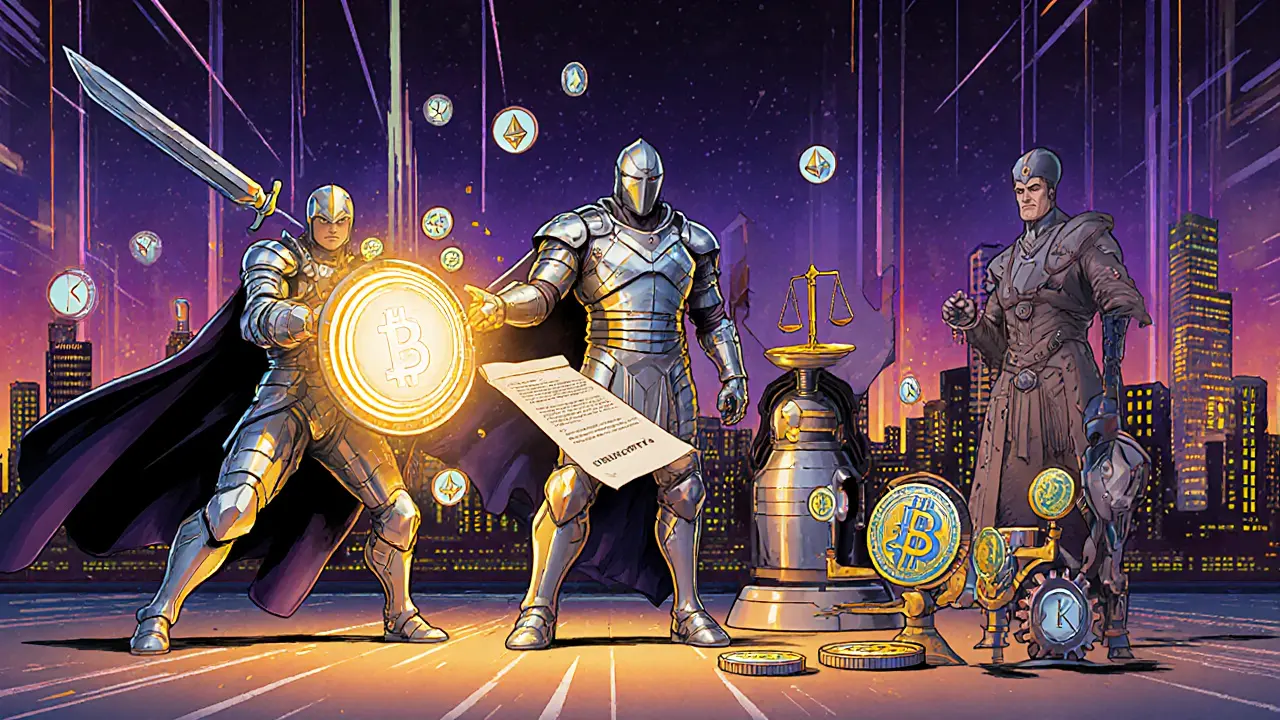DeFi Yield Calculator
Calculate Your Yield
Results
Enter your investment details to see potential returns
Decentralized finance, or DeFi is a financial ecosystem built on blockchain that removes traditional middlemen and runs on smart contracts, has turned the crypto world into a full‑blown banking alternative. In 2025 the sector holds about $156 billion in total value locked, a figure that tells a story of consolidation, regulation, and rapid tech upgrades. This guide walks you through the most important protocols, the layers they run on, real‑world use cases, and the risks you need to manage before diving in.
Why DeFi matters today
Traditional finance relies on banks, custodians, and clearinghouses that decide who gets access and at what cost. DeFi flips that model: anyone with an internet connection, a crypto wallet, and a few dollars for gas can trade, borrow, lend, or earn yields, all without signing a paper form. The transparency of public ledgers means every transaction is visible to anyone, while cryptographic signatures keep ownership private. For developers and investors, this opens up three clear jobs:
- Find a protocol that matches a specific financial need (swap, loan, stablecoin, yield).
- Assess the security and regulatory profile before committing capital.
- Integrate the chosen protocol into a product or personal strategy.
Meeting those jobs requires a solid grasp of the underlying architecture, which we break down next.
Core architecture: smart contracts and network layers
All DeFi activity lives inside Ethereum is a public blockchain that introduced programmable smart contracts in 2015. As of Q3 2025, Ethereum still powers 58 % of DeFi volume, but Layer 2 solutions now handle roughly three‑quarters of all transactions, slashing gas fees by up to 97 %.
Layer 2s such as Optimism and Arbitrum bundle dozens of L1 transactions into a single rollup, then post the compressed proof to Ethereum. This design keeps the security guarantees of the base chain while delivering 10‑30× higher throughput.
Other blockchains like Polygon, Avalanche, and Solana host their own DeFi ecosystems. They compete on speed and cost, but most of today’s cross‑chain bridges rely on Ethereum‑centric standards, meaning a solid Ethereum foundation is still a prerequisite.
Key protocol categories and leading players
DeFi protocols cluster into four functional groups. Below each group we list the market leader, its unique selling point, and the typical user profile.
- Decentralized Exchanges (DEXs) - Platforms where users swap tokens directly from their wallets. Uniswap dominates with $1.2 trillion of annual trading volume. Its concentrated liquidity model lets liquidity providers (LPs) earn 80 % of fees using only 20 % of capital.
- Lending & Borrowing - Protocols that match lenders with borrowers via over‑collateralized smart contracts. Aave leads with $18.7 billion in outstanding loans and offers features like credit delegation and flash loans.
- Stablecoin Systems - Soft‑pegged digital assets that aim to hold a 1:1 value with fiat. MakerDAO issues DAI, keeping peg accuracy at 99.87 % in 2025 through automated collateral auctions.
- Yield Optimizers - Services that automatically move capital to the highest‑yielding pool. Curve Finance specializes in stablecoin swaps, delivering 3.2‑5.7 % APY for LPs while keeping slippage under 0.04 %.
Choosing the right protocol hinges on three questions: what asset are you moving, how much risk you can tolerate, and whether you need cross‑chain flexibility.

Comparing the top DeFi protocols
| Protocol | Core Function | TVL (Billions $) | Unique Feature | Major Risk |
|---|---|---|---|---|
| Uniswap | DEX (AMM) | 1,200 | Concentrated liquidity | High impermanent loss |
| Aave | Lending/Borrowing | 18.7 | Credit delegation | Collateral liquidation spikes |
| MakerDAO | Stablecoin (DAI) | 6.2 | Governance‑driven risk parameters | Slow governance response |
| Curve Finance | Stablecoin swaps | 487 | Low‑slippage pools | Complex UI for newcomers |
When you map the table to your own goals, the decision becomes clearer. Want deep liquidity for a token swap? Uniswap. Need to borrow USDC against ETH with a decent rate? Aave. Looking for a pegged asset to park cash? DAI via MakerDAO. Seeking ultra‑low slippage stablecoin yields? Curve.
Real‑world use cases in 2025
- Cross‑border payroll: A startup in Kenya pays freelancers in the US using DAI. Employees convert DAI to local fiat via a regulated bridge, cutting conversion fees from 3 % to under 0.5 %.
- Institutional yield farming: A hedge fund allocates $200 million to Curve’s 3‑pool, earning a steady 4.9 % APY while using a DAO‑managed risk overlay that rebalances when volatility exceeds 5 %.
- Liquidity mining for token launches: A new DeFi gaming token launches on Uniswap v4, offering LPs a 25 % share of platform fees for a 30‑day mining window, boosting initial TVL by $50 million.
- Tokenized real‑world assets: Ondo Finance packages a $100 million commercial real‑estate fund into ERC‑20 shares, then lets borrowers access those shares as collateral on Aave.
These examples illustrate how the same building blocks-smart contracts, token standards, and interoperable bridges-can be assembled for very different business models.
Getting started: step‑by‑step checklist
- Install a non‑custodial wallet (MetaMask is the most widely supported). MetaMask is a browser extension that manages private keys and connects to Ethereum and many L2 networks.
- Buy a small amount of ETH or the native token of your chosen L2 (e.g., OP for Optimism). Aim for at least $5 to cover gas.
- Send a test transaction (e.g., a $0.02 swap on a testnet DEX) to verify your wallet and gas settings.
- Navigate to the protocol’s official UI (uniswap.org, aave.com, makerdao.com, curve.fi). Connect your wallet and approve the token you’ll use.
- Set slippage tolerance (usually 0.5‑1 %). Confirm the transaction, wait for the confirmation block, then record the transaction hash.
- Use a transaction simulator like DeBank’s “Simulate” button before each major move. This cuts failed‑transaction rates from 12 % to under 5 %.
After the basics, you can explore advanced strategies such as multi‑hop arbitrage, composable yield farming, or governance voting. Each adds complexity, so allocate at least 20‑40 hours of study before risking large sums.

Risks you can’t ignore
DeFi’s promise of open finance comes with three hard‑nosed risks.
- Smart‑contract bugs: 2024 saw $1.2 billion lost to exploits. Audited contracts reduce risk, but no code is immutable forever.
- Regulatory uncertainty: The EU’s MiCA framework now forces stablecoin issuers to verify identities, while the U.S. still debates classification. A protocol could be forced offline in a jurisdiction overnight.
- Economic volatility: Rapid price swings trigger liquidations and impermanent loss. During the 2023 UST de‑pegging, many Aave loans were wiped out within seconds.
Mitigation tactics include diversifying across chains, using insured vaults like Nexus Mutual, and keeping a small cash reserve to cover unexpected gas spikes.
Future outlook: where DeFi heads after 2025
Three trends will shape the next wave.
- AI‑driven risk engines: By mid‑2026, 87 % of top protocols plan to embed machine‑learning models that flag abnormal borrowing patterns.
- Cross‑chain messaging (CCIP): Interoperability will move from bridges to standardized messaging, allowing a single transaction to execute on Ethereum, Polygon, and Avalanche simultaneously.
- Real‑world asset tokenization: The World Economic Forum predicts $160 billion of tokenized assets by 2027, with DeFi serving as the settlement layer for everything from invoices to property deeds.
If you’re building a product, start wiring CCIP‑compatible contracts now. If you’re an investor, look for protocols that have already piloted decentralized identity solutions, as they will be better positioned for future compliance.
Quick checklist for seasoned users
- Verify contract address on official docs before approving tokens.
- Set gas price limits using a fee estimator (Etherscan or GasNow).
- Enable 2‑FA on your wallet seed phrase backup.
- Track TVL and protocol health metrics on DeFi Llama.
- Stay updated on regulatory announcements via CoinDesk and the EU’s official gazette.
What is the difference between a DEX and a centralized exchange?
A DEX like Uniswap lets you trade directly from your wallet using smart contracts, so you never hand over custody of your assets. A centralized exchange holds your funds in-house and matches orders off‑chain, which can be faster but introduces counter‑party risk.
How much gas should I keep in my wallet for a typical DeFi transaction?
On Ethereum mainnet, most swaps cost between $1 and $5. On Optimism or Arbitrum, you can expect $0.02‑$0.10. It’s wise to keep a $5‑$10 buffer to cover spikes.
Can I earn yield on stablecoins without impermanent loss?
Yes. Protocols like Curve Finance specialize in stablecoin pools, where all assets maintain the same price, eliminating impermanent loss while still delivering 3‑6 % APY.
What happens if a DeFi protocol gets a regulatory injunction?
If the protocol’s smart contracts are immutable, the code still runs, but front‑ends may be taken down, and on‑ramps/off‑ramps could be blocked. Users often switch to forked versions that retain the same contracts but new branding.
Is it safe to use a hardware wallet with DeFi apps?
Hardware wallets like Ledger and Trezor keep your private keys offline. When you approve a transaction, the device signs it securely, which is the safest way to interact with DeFi.



mike ballard
October 19 2025Liquidity mining on Uniswap v4 leverages concentrated liquidity to maximize capital efficiency 🧠🚀.